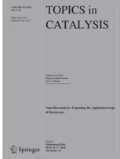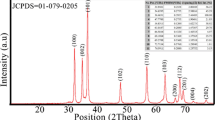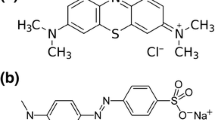Abstract
The aim of this work is to preliminary investigate the photocatalytic performances toward the removal of eriochrome black-T dye under UV and visible irradiation using Eu-doped ZnO obtained through a supercritical antisolvent (SAS) process in comparison with Eu-doped ZnO prepared by drying-precipitation method and Eu-doped TiO2 prepared by sol–gel route. XRD patterns show that the presence of Eu+3 does not change the crystalline structure of both TiO2 and ZnO, evidencing that Eu+3 is successfully incorporated into the semiconductors lattice. The morphology of samples obtained after SAS micronization consists of nanoparticles with a regular shape and characterized by average size in the range 65.0–84.7 nm. UV–Vis DRS spectra evidence that the doping of TiO2 and ZnO with Eu+3 leads to an increase of band gap value with respect to undoped samples because of the presence of dopant ions into the host structure. Eu-doped ZnO sample synthetized by the SAS process shows better photocatalytic efficiency in terms of both discoloration and mineralization, reaching the almost total dye removal after 240 min of UV light irradiation. The enhancement of the photocatalytic activity of Eu-doped ZnO sample synthetized by SAS process is ascribed to the presence of Eu+3 in the lattice, but also to the higher specific surface area, smaller crystallite size and its morphology features, if compared with Eu-doped ZnO prepared by drying-precipitation method and Eu-doped TiO2 prepared by sol–gel route.






Similar content being viewed by others
References
Pessoni H, Maia L, Franco A Jr (2015) Eu-doped ZnO nanoparticles prepared by the combustion reaction method: Structural, photoluminescence and dielectric characterization. Mater Sci Semicond Process 30:135–141
Daksh D, Agrawal YK (2016) Rare earth-doped zinc oxide nanostructures: a review. Rev Nanosci Nanotechnol 5(1):1–27
Cerrato E, Gionco C, Berruti I, Sordello F, Calza P, Paganini MC (2018) Rare earth ions doped ZnO: synthesis, characterization and preliminary photoactivity assessment. J Solid State Chem 264:42–47
Ntwaeaborwa OM, Mofokeng SJ, Kumar V, Kroon RE (2017) Structural, optical and photoluminescence properties of Eu3+ doped ZnO nanoparticles. Spectrochim Acta Part A 182:42–49
Dash D, Panda N, Sahu D (2019) Photoluminescence and photocatalytic properties of europium doped ZnO nanoparticles. Appl Surf Sci 494:666–674
Trandafilović LV, Jovanović DJ, Zhang X, Ptasińska S, Dramićanin M (2017) Enhanced photocatalytic degradation of methylene blue and methyl orange by ZnO: Eu nanoparticles. Appl Catal B 203:740–752
Korake P, Kadam A, Garadkar K (2014) Photocatalytic activity of Eu3+-doped ZnO nanorods synthesized via microwave assisted technique. J Rare Earths 32(4):306–313
Vaiano V, Sacco O, Sannino D, Ciambelli P (2015) Process intensification in the removal of organic pollutants from wastewater using innovative photocatalysts obtained coupling Zinc Sulfide based phosphors with nitrogen doped semiconductors. J Clean Prod 100:208–211
Sacco O, Vaiano V, Daniel C, Navarra W, Venditto V (2019) Highly robust and selective system for water pollutants removal: how to transform a traditional photocatalyst into a highly robust and selective system for water pollutants removal. Nanomaterials 9(11):1509
Pirilä M, Saouabe M, Ojala S, Rathnayake B, Drault F, Valtanen A, Huuhtanen M, Brahmi R, Keiski RL (2015) Photocatalytic degradation of organic pollutants in wastewater. Top Catal 58(14–17):1085–1099
Sannino D, Vaiano V, Ciambelli P (2013) Innovative structured VOx/TiO2 photocatalysts supported on phosphors for the selective photocatalytic oxidation of ethanol to acetaldehyde. Catal Today 205:159–167
Ciambelli P, Sannino D, Palma V, Vaiano V, Eloy P, Dury F, Gaigneaux EM (2007) Tuning the selectivity of MoOx supported catalysts for cyclohexane photo oxidehydrogenation. Catal Today 128(3–4):251–257
Parrino F, Bellardita M, García-López E, Marcì G, Loddo V, Palmisano L (2018) Heterogeneous photocatalysis for selective formation of high-value-added molecules: Some chemical and engineering aspects. ACS Catal 8(12):11191–11225
Vaiano V, Sarno G, Sacco O, Sannino D (2017) Degradation of terephthalic acid in a photocatalytic system able to work also at high pressure. Chem Eng J 312:10–19
Vaiano V, Matarangolo M, Sacco O (2018) UV-LEDs floating-bed photoreactor for the removal of caffeine and paracetamol using ZnO supported on polystyrene pellets. Chem Eng J 350:703–713
Štrbac D, Aggelopoulos CA, Štrbac G, Dimitropoulos M, Novaković M, Ivetić T, Yannopoulos SN (2018) Photocatalytic degradation of Naproxen and methylene blue: comparison between ZnO, TiO2 and their mixture. Process Saf Environ Prot 113:174–183
Ba-Abbad MM, Kadhum AAH, Mohamad AB, Takriff MS, Sopian K (2013) Visible light photocatalytic activity of Fe3+-doped ZnO nanoparticle prepared via sol–gel technique. Chemosphere 91(11):1604–1611
Khatamian M, Khandar A, Divband B, Haghighi M, Ebrahimiasl S (2012) Heterogeneous photocatalytic degradation of 4-nitrophenol in aqueous suspension by Ln (La3+, Nd3+ or Sm3+) doped ZnO nanoparticles. J Mol Catal A 365:120–127
Lee H, Hong JA (2018) Surface spectroscopic analysis of TiO2 and ZnO nanoparticles doped with noble metals. Top Catal 61(12–13):1257–1262
Zong Y, Li Z, Wang X, Ma J, Men Y (2014) Synthesis and high photocatalytic activity of Eu-doped ZnO nanoparticles. Ceram Int 40(7):10375–10382
Marin R, Oussta F, Katea SN, Prabhudev S, Botton GA, Westin G, Hemmer E (2019) Europium-doped ZnO nanosponges–controlling optical properties and photocatalytic activity. J Mater Chem C 7(13):3909–3919
Ariga K, Hill JP, Lee MV, Vinu A, Charvet R, Acharya S (2008) Challenges and breakthroughs in recent research on self-assembly. Sci Technol Adv Mater 9(1):014109
Paul N, Mohanta D (2013) Physical properties of nanoscale TiO2 with mild rare earth ion doping. In: International Conference on Advanced Nanomaterials & Emerging Engineering Technologies, 2013. IEEE, pp 167–171
Pandey P, Kurchania R, Haque FZ (2014) Optical studies of europium-doped ZnO nanoparticles prepared by sol–gel technique. J Adv Phys 3(2):104–110
Gao S, Zhang H, Deng R, Wang X, Sun D, Zheng G (2006) Engineering white light-emitting Eu-doped ZnO urchins by biopolymer-assisted hydrothermal method. Appl Phys Lett 89(12):123125
Ishizumi A, Kanemitsu Y (2005) Structural and luminescence properties of Eu-doped ZnO nanorods fabricated by a microemulsion method. Appl Phys Lett 86(25):253106
Lupan O, Viana B, Pauporté T, Dhaouadi M, Pellé F, Devys L, Gacoin T (2013) Controlled mixed violet–blue–red electroluminescence from Eu: nano-phosphors/ZnO-nanowires/p-gan light-emitting diodes. J Phys Chem C 117(50):26768–26775
Swapna R, SrinivasaReddy T, Venkateswarlu K, Kumar M (2015) Effect of post-annealing on the properties of Eu doped ZnO nano thin films. Procedia Mater Sci 10:723–729
Pauporte T, Pelle F, Viana B, Aschehoug P (2007) Luminescence of nanostructured Eu3+/ZnO mixed films prepared by electrodeposition. J Phys Chem C 111(42):15427–15432
Vaiano V, Matarangolo M, Sacco O, Sannino D (2017) Photocatalytic treatment of aqueous solutions at high dye concentration using praseodymium-doped ZnO catalysts. Appl Catal B 209:621–630
Franco P, Martino M, Palma V, Scarpellini A, De Marco I (2018) Pt on SAS-CeO2 nanopowder as catalyst for the CO-WGS reaction. Int J Hydrogen Energy 43(43):19965–19975
Marin RP, Kondrat SA, Davies TE, Morgan DJ, Enache DI, Combes GB, Taylor SH, Bartley JK, Hutchings GJ (2014) Novel cobalt zinc oxide Fischer-Tropsch catalysts synthesised using supercritical anti-solvent precipitation. Catal Sci Technol 4(7):1970–1978
Jiang H, Zhang L, Zhao J, Li Y, Zhang M (2016) Study on MnOx–FeOy composite oxide catalysts prepared by supercritical antisolvent process for low-temperature selective catalytic reduction of NOx. J Mater Res 31(6):702–712
Da Silva EP, Winkler ME, Giufrida WM, Cardozo-Filho L, Alonso CG, Lopes JB, Rubira AF, Silva R (2019) Effect of phase composition on the photocatalytic activity of titanium dioxide obtained from supercritical antisolvent. J Colloid Interface Sci 535:245–254
Marin RP, Ishikawa S, Bahruji H, Shaw G, Kondrat SA, Miedziak PJ, Morgan DJ, Taylor SH, Bartley JK, Edwards JK (2015) Supercritical antisolvent precipitation of TiO2 with tailored anatase/rutile composition for applications in redox catalysis and photocatalysis. Appl Catal A 504:62–73
Franco P, Sacco O, De Marco I, Vaiano V (2019) Zinc oxide nanoparticles obtained by supercritical antisolvent precipitation for the photocatalytic degradation of crystal violet dye. Catalysts 9(4):346
Kansal SK, Sood S, Umar A, Mehta S (2013) Photocatalytic degradation of Eriochrome Black T dye using well-crystalline anatase TiO2 nanoparticles. J Alloy Compd 581:392–397
Vaiano V, Matarangolo M, Sacco O, Sannino D (2017) Photocatalytic removal of eriochrome black T dye over ZnO nanoparticles doped with Pr, Ce or Eu. Chem Eng Trans 57:625–630
Al-Taweel SS, Saud HR (2016) New route for synthesis of pure anatase TiO2 nanoparticles via utrasound-assisted sol-gel method. J Chem Pharm Res 8(2):620–626
Kołodziejczak-Radzimska A, Markiewicz E, Jesionowski T (2012) Structural characterisation of ZnO particles obtained by the emulsion precipitation method. J Nanomater. https://doi.org/10.1155/2012/656353
Parrino F, Deiana C, Chierotti MR, Martra G, Palmisano L (2016) Formation of dibutyl carbonate and butylcarbamate via CO2 insertion in titanium (IV) butoxide and reaction with n-butylamine. J CO2 Util 13:90–94
Konnov S, Serebrennikov L, Mal'tsev A (1982) Infrared spectra of interaction products of europium and ytterbium with oxygen and nitrogen monoxide in argon matrix. Zhurnal Neorganicheskoj Khimii 27(3):654–660
Pal M, Pal U, Jiménez JMGY, Pérez-Rodríguez F (2012) Effects of crystallization and dopant concentration on the emission behavior of TiO2: Eu nanophosphors. Nanoscale Res Lett 7(1):1–12
Hsiao RC, Arul NS, Mangalaraj D, Juang RS (2010) Influence of Eu3+ doping on the degradation property of TiO2 nanostructures. J Optoelectron Adv Mater 12(2):193
Yurtsever HA, Çiftçioğlu M (2017) The effect of rare earth element doping on the microstructural evolution of sol-gel titania powders. J Alloy Compd 695:1336–1353
Omar NAS, Fen YW, Matori KA (2016) Photoluminescence properties of Eu3+-doped low cost zinc silicate based glass ceramics. Optik 127(8):3727–3729
Pandey P, Parra MR, Kurchania R, Haque FZ (2014) Synthesis and optical properties of pure and Eu+3 ion doped ZnO nanoparticles prepared via Sol-Gel method. In: Physics of Semiconductor Devices. Springer, pp 599–600
Dhara S, Raychaudhuri A (2017) Enhancement in red emission at room temperature from europium doped ZnO nanowires by 1, 10 phenanthroline-europium interface induced resonant excitations. AIP Adv 7(2):025306
Filippo E, Carlucci C, Capodilupo AL, Perulli P, Conciauro F, Corrente GA, Gigli G, Ciccarella G (2015) Enhanced photocatalytic activity of pure anatase TiO2 and Pt-TiO2 nanoparticles synthesized by green microwave assisted route. Mater Res 18(3):473–481
Pal PP, Manam J (2013) Structural and photoluminescence studies of Eu3+ doped zinc oxide nanorods prepared by precipitation method. J Rare Earths 31(1):37–43
Bachir S, Azuma K, Kossanyi J, Valat P, Ronfard-Haret J (1997) Photoluminescence of polycrystalline zinc oxide co-activated with trivalent rare earth ions and lithium. Insertion of rare-earth ions into zinc oxide. J Luminesc 75(1):35–49
Jia T, Wang W, Long F, Fu Z, Wang H, Zhang Q (2009) Fabrication, characterization and photocatalytic activity of La-doped ZnO nanowires. J Alloy Compd 484(1–2):410–415
Burstein E (1954) Anomalous optical absorption limit in InSb. Phys Rev 93(3):632
Moss T (1954) The interpretation of the properties of indium antimonide. Proc Phys Soc Lond Sect B 67(10):775
El Fakir A, Sekkati M, Schmerber G, Belayachi A, Edfouf Z, Regragui M, Cherkaoui El Moursli F, Sekkat Z, Dinia A, Slaoui A (2017) Influence of rare earth (Nd and Tb) co-doping on ZnO thin films properties. Phys Status Solidi C 14(10):1700169
Teoh WY, Amal R, Mädler L, Pratsinis SE (2007) Flame sprayed visible light-active Fe-TiO2 for photomineralisation of oxalic acid. Catal Today 120(2):203–213
Serpone N, Emeline AV, Kuznetsov VN, Ryabchuk VK (2010) Second generation visible-light-active photocatalysts: preparation, optical properties, and consequences of dopants on the band gap energy of TiO2. In: Anpo N, Kamat PV (eds) Environmentally benign photocatalysts. Springer, New York, pp 35–111
Aggelopoulos CA, Dimitropoulos M, Govatsi A, Sygellou L, Tsakiroglou CD, Yannopoulos SN (2017) Influence of the surface-to-bulk defects ratio of ZnO and TiO2 on their UV-mediated photocatalytic activity. Appl Catal B 205:292–301
Weber AS, Grady AM, Koodali RT (2012) Lanthanide modified semiconductor photocatalysts. Catal Sci Technol 2(4):683–693
Khatamian M, Divband B, Jodaei A (2012) Degradation of 4-nitrophenol (4-NP) using ZnO nanoparticles supported on zeolites and modeling of experimental results by artificial neural networks. Mater Chem Phys 134(1):31–37
Ajala F, Hamrouni A, Houas A, Lachheb H, Megna B, Palmisano L, Parrino F (2018) The influence of Al doping on the photocatalytic activity of nanostructured ZnO: the role of adsorbed water. Appl Surf Sci 445:376–382
Grundmann M (2010) Physics of semiconductors, 11th edn. Springer, New York
Hernández-Carrillo M, Torres-Ricárdez R, García-Mendoza M, Ramírez-Morales E, Rojas-Blanco L, Díaz-Flores L, Sepúlveda-Palacios G, Paraguay-Delgado F, Pérez-Hernández G (2018) Eu-modified ZnO nanoparticles for applications in photocatalysis. Catal Today. https://doi.org/10.1016/j.cattod.2018.04.060
Acknowledgements
The authors wish to thank Prof. Vincenzo Venditto and Doctor Wanda Navarra for XRD measurements. The authors also acknowledge Ilaria Celentano for her help in performing part of the experiments during her bachelor thesis at the University of Salerno.
Funding
This research received funding from University of Salerno for the projects “Catalizzatori Eterogenei Innovativi per Processi Chimici Sostenibili” (FARB 2017) and “Formulazioni catalitiche innovative per la sostenibilità energetica ed ambientale dei processi chimici” (FARB 2018).
Author information
Authors and Affiliations
Corresponding authors
Ethics declarations
Conflict of interest:
The authors declare that they have no conflict of interest.
Additional information
Publisher's Note
Springer Nature remains neutral with regard to jurisdictional claims in published maps and institutional affiliations.
Electronic supplementary material
Below is the link to the electronic supplementary material.
Rights and permissions
About this article
Cite this article
Franco, P., Sacco, O., De Marco, I. et al. Photocatalytic Degradation of Eriochrome Black-T Azo Dye Using Eu-Doped ZnO Prepared by Supercritical Antisolvent Precipitation Route: A Preliminary Investigation. Top Catal 63, 1193–1205 (2020). https://doi.org/10.1007/s11244-020-01279-y
Published:
Issue Date:
DOI: https://doi.org/10.1007/s11244-020-01279-y




